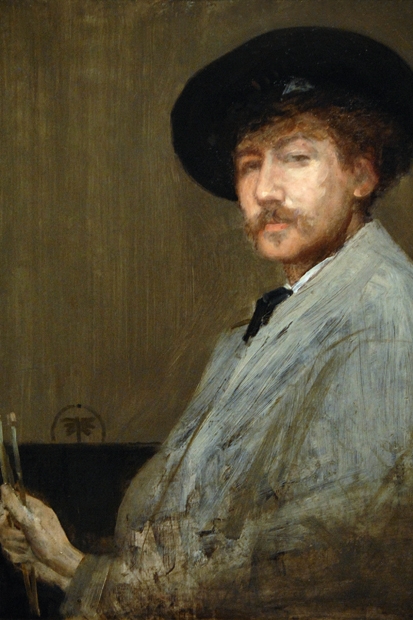When James Whistler was two years old, he was asked why he’d disappeared from company and hidden under a table. ‘I’s drawrin,’ he replied. He started as he meant to go on. Daniel E. Sutherland’s well-appointed new biography of the American-born painter — whom Henry James described as a ‘queer little Londonised Southerner’ — keeps the attention there, making its central emphasis Whistler’s ferocious single-mindedness in the making of his art.
The striking thing is how much the other aspects of him — Whistler the rebel, Whistler the public combatant, Whistler the philanderer, the dandy, the show-off, the semi-delinquent father, the wit and conversationalist — fed into that rather than distracting from it. His dedication to art did not entail a retreat from the world but, rather, an energised engagement with it.
Whistler in this account seems both worldly and unworldly in different ways. He was hopeless with money and despite that, or only in part because of it, he was very interested in getting it. Dedicated to art for art’s sake, he was also dedicated to money for art’s sake. Even if that occasionally meant, as he said, making some money grinding out portraits of ‘the heads of blokes’ and ‘their pet ballet dancers’. Or, less conventionally, getting involved in an abortive scheme to sell steam-powered torpedo boats to Mexico and Peru for use against the Spanish naval blockade.
Whistler was extraordinarily modern in the way he marketed himself as an artist. As Sutherland puts it, ‘he saw no difference between the creation and promotion of art’. He was, to bring in the cliché, determined to create the taste by which his work would be enjoyed, and that meant not only selling his art but creating himself as a singular artistic personality and promulgating his theories of art as a pamphleteer and lecturer.

He made himself a brand, signing himself — The Artist Formerly Known As Whistler? — with a butterfly logo. That aptly signified a refusal to settle (he lived nowhere for very long, roaming from house to house, city to city and — until his late and happy marriage — woman to woman), a flashy comportment (the young Max Beerbohm impudently wrote that ‘While other great painters have, for good and ill, been tearing their hair, he has been arranging his before a mirror’) and, of course, everything that insect signifies when prefaced with the word ‘social’.
He was a theatrical and highly charismatic conversationalist. He used jokes, too, to laugh off trouble. Late for work in an early job as a draughtsman for a surveying company, he protested that he was never late; the office simply opened too early. Booted out of West Point for failing chemistry, he said later that had silicon been a gas he would have been a major-general. When, invited on a shooting party, he missed the grouse and shot dead his host’s dog, he declared: ‘It was a dog without artistic habits and had placed itself badly in relation to the landscape.’
In addition to selling himself as a genius, he also took a very modern attitude to putting his work in context — attending not only to how his pictures were hung, but to the frames as an extension of the pictures themselves, and to the galleries as part of the aesthetic experience. His ‘mustard-pot’ show in 1883 was a riot of cream and yellow, with a liveried attendant, according to Whistler, ‘one of the elements of the exhibition’.
The prices of his paintings mattered to him: not just to pay the bills (he was once, humiliatingly, sued by his cheesemonger) but because it was an index of his reputation. We now hear of gallerists bidding to ensure that the sale prices of their artists remain high, but Whistler understood the stock-market behaviour of the art world even then. Dismayed when the owner of one of his works was offered a low price for it, he said: ‘The great point is not the changing of ownership of these pictures, which is scarcely interesting to me, but to confirm, by every transaction, my large prices.’

He may have floated like a butterfly but — ow! — he also stung like a bee. The feuding was ceaseless. He fell out with practically everybody he ever befriended: Ruskin, Wilde, Swinburne and his brother-in-law and early mentor Francis Seymour Haden were only the best known. Nor was he above throwing the odd punch. He duffed up Parisian cabbies, broke his hand on a fellow passenger aboard a steamer (‘the black scoundrel deserved his kicking’) and literally kicked the arse of a fellow painter in the Hogarth Club.
‘There is nothing like a good fight!’ he declared. In youth and middle age his pugnacity seemed to give him energy — he would have relished, Sutherland suggests, the acronym in his memoir The Gentle Art of Making Enemies — and he crowed about taking ‘scalps’.
Even his painting style was combative. ‘His movements were those of a duellist fencing actively and cautiously with the small sword,’ one observer recalled. Clutching a sheaf of long-handled brushes he ‘advanced, retreated, crouched, peered, darted forward, and fell back for an hour or two at a time, now and then touching his “weapon” to canvas’.
His failed military education seems to have marked his psyche: he prided himself on his West Point years (though he was a useless student there) and this warrior of the dado rail later on awarded himself the facetious rank of ‘General’. By old age the zest and playfulness had gone: there was less of the swashbuckler and more of the mere curmudgeon about him. His pride in his feuds was part of his self-fashioning. He published and promoted accounts of his bickerings, and in late life —newspapers having got wind of his failing health — he rebuked one for its ‘premature’ eulogy by complaining that it had said too little about the people he had offended. He must have been wearying to his friends, but they indulged him. One of them said: ‘Whistler is like a woman; like a mistress you love, despite all the trouble she gives you.’
The main reason to love Whistler, after all, is the remarkable paintings that emerged from his exhausting life. Sutherland’s account, under the gossip, is unobtrusively scholarly and he is a sensible explainer of the work, accessible and illuminating to the general reader. We get three thick wodges of plates, so the paintings are on hand. He knew everybody, learned what he needed to learn and became singular. Sutherland deftly explains how.
Plus, of course, Whistler was the man who had the fourth most famous mother in history after Jesus Christ, Oedipus and Principal Skinner in The Simpsons. That, too, came into his theory of art: ‘Yes,’ he said, ‘one does like to make one’s mummy just as nice as possible.’






Comments